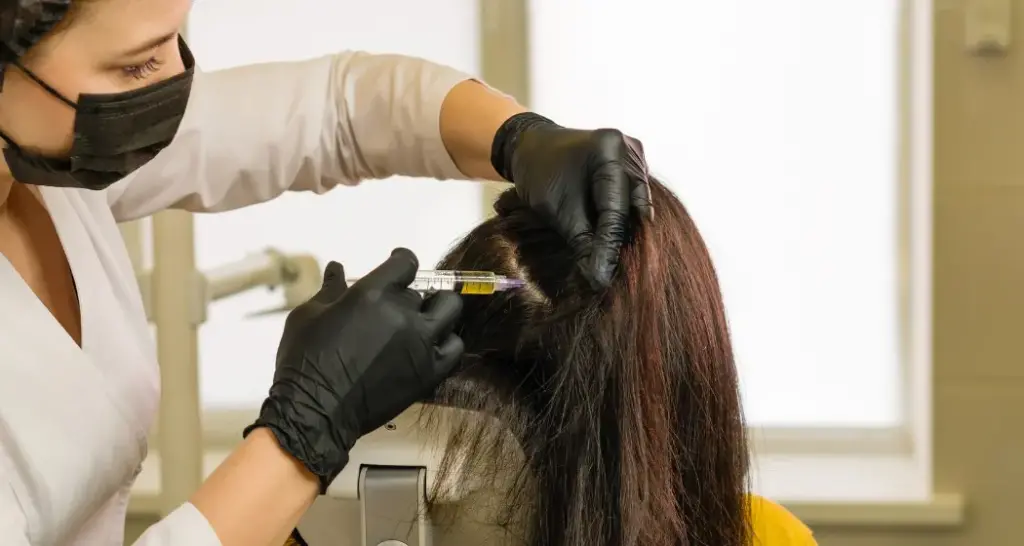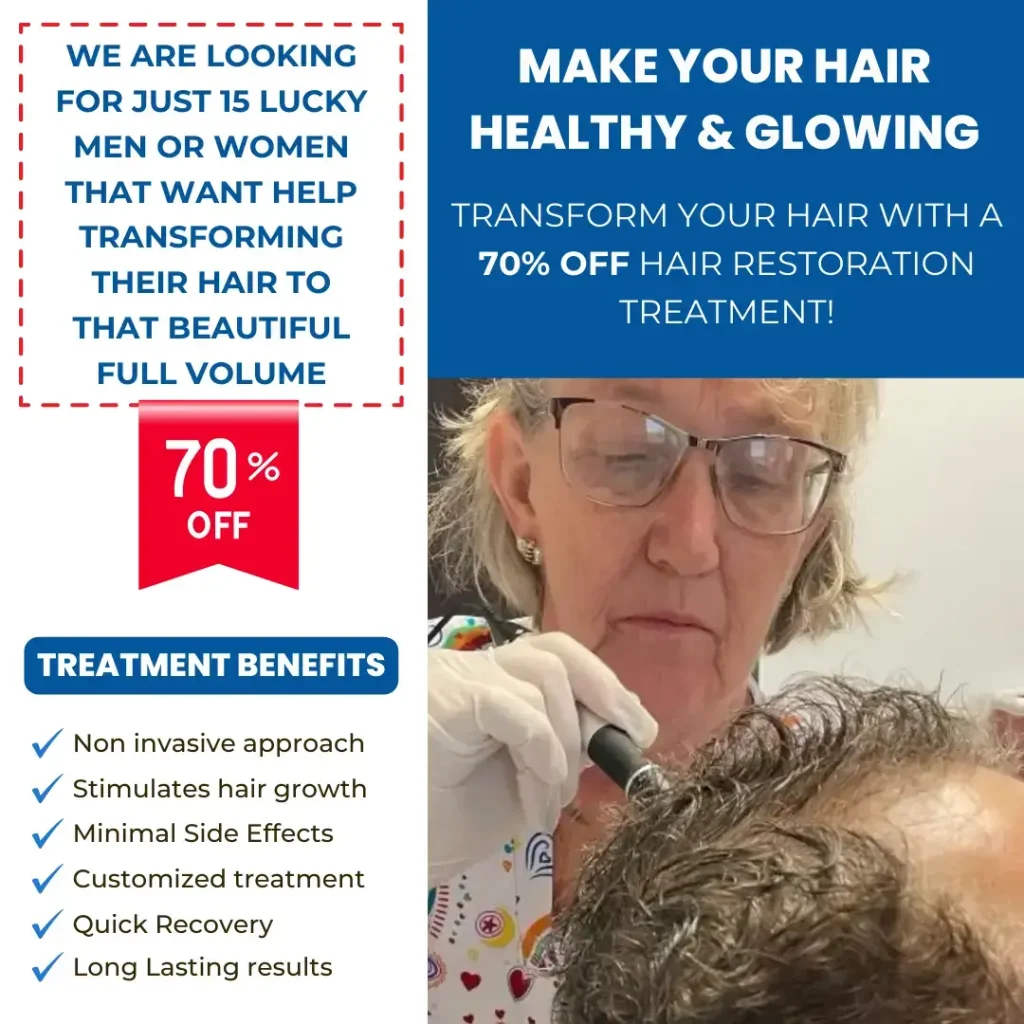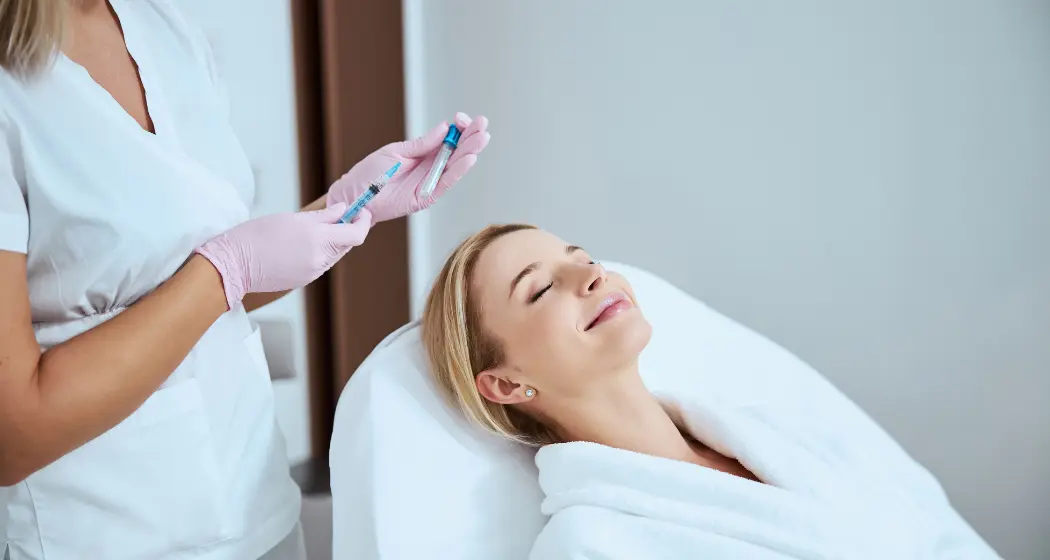Platelet-rich plasma (PRP) therapy is revolutionizing hair restoration. It offers a non-surgical, minimally invasive treatment. PRP therapy concentrates platelets from the patient’s blood, stimulating hair follicles. It enhances hair growth and density. This article explores the science, procedure, benefits, and future of Platelet-Rich Plasma hair restoration treatments. It sheds light on why it’s gaining popularity among those combating hair loss.
Key Takeaways
- PRP therapy is a promising, non-surgical option for hair restoration that uses the patient’s own blood to stimulate hair growth and follicle strength.
- The procedure is remarkable quick and involves minimal discomfort, with a strong safety profile and short recovery time.
- Smart PRP, an advanced version of traditional PRP therapy, offers a refined technique for even better hair restoration results.
- PRP demonstrates efficacy across diverse forms of hair loss and holds promise in enhancing the quality and texture of existing hair, supported by studies indicating favorable outcomes for the majority of patients.
- The future of PRP hair restoration looks bright, with ongoing innovations in techniques and the potential to combine with other therapies for enhanced effects.
Understanding Platelet-Rich Plasma (PRP) Therapy
Platelet-Rich Plasma (PRP) therapy represents groundbreaking approach to hair restoration that leverages the body’s natural healing mechanisms. PRP is rich in growth factors crucial for stimulating hair follicles and promoting hair growth. Among these growth factors include platelet-derived growth factor (PDGF), transforming growth factor-beta (TGF-eta), vascular endothelial growth factor (VEGF), and insulin-like growth factor (IGF), all of which play a pivotal role in tissue regeneration and angiogenesis.
The Science Behind PRP and Hair Growth
PRP therapy not only activates dormant hair follicles but also nourishes and protects existing ones, improving their lifespan and vitality. The treatment involves extracting a small volume of the patient’s blood. After processing, the procedure isolates and concentrates the platelets before injecting the PRP into the scalp. This process enhances the blood supply to the follicles, ensuring they receive ample nutrients and oxygen for sustained hair growth.

The benefits of PRP therapy are not just limited to hair growth; it also contributes to the overall health of the hair by boosting thickness and resilience. With minimal discomfort and downtime, PRP presents a natural solution for individuals aiming to address loss and enhance hair vitality.
Comparing PRP to Traditional Hair Loss Treatments
Platelet-Rich Plasma (PRP) therapy risen to prominence as a notable alternative to traditional hair loss treatments, addressing the fundamental cause of hair loss and promoting quicker recovery. Unlike treatments such as minoxidil or hair transplants, PRP therapy is known for its natural approach, utilizing the body’s own healing mechanisms to stimulate hair follicles.
PRP therapy for hair loss has excellent results, especially when combined with other treatments, enhancing the comprehensive strategy for hair restoration.
While PRP therapy can yield significant improvements in hair density and quality, it is important to note that it is not a one-time solution. Maintenance sessions every four to six months sustain results. This consideration is crucial when evaluating PRP therapy’s cost and commitment versus other options.
Here is a comparison of PRP therapy with traditional hair loss treatments:
- PRP Therapy: Promotes hair growth, natural-looking results, minimal invasiveness, regular maintenance needed.
- Hair Transplant: Usually a single procedure, extensive results, more invasive.
- Minoxidil: Topical treatment, can slow down hair loss, continuous use required.
Safety and Efficacy of PRP Hair Restoration
Platelet-Rich Plasma (PRP) therapy emerges as a minimally invasive, non-surgical solution for hair restoration. Additionally, it stimulates hair growth using the body’s healing mechanisms. The procedure’s safety is underscored by its reliance on the patient’s own blood, thereby reducing the chances of allergic reactions or transmission of infectious diseases.
Clinical studies support the efficacy of PRP therapy, with many patients experiencing increased hair thickness and count. These benefits often persist for several months after the treatment course.
The safety profile of PRP is robust, with most side effects being mild and transient. The versatility of PRP is evident as it effectively addresses various types and stages of hair loss, enhancing the quality and texture of hair. This positions PRP as a compelling choice for those seeking natural-looking results without invasive procedures.
| Outcome | Description |
| Hair Thickness | Increased in a significant number of participants |
| Hair Count | Many observed a higher count post-treatment |
| Side Effects | Mostly mild and short-lived |
| Recovery Time | Short, with quick return to daily activities |
In summary, PRP therapy offers a balance of effectiveness and safety, making it an attractive option for individuals looking to combat hair loss with confidence and comfort.
The PRP Hair Restoration Procedure
The transformative journey of PRP hair treatment begins with a meticulous process designed to promote hair regrowth. Here’s a concise step-by-step guide to what you can expect during the procedure:
Step-by-Step Guide to the PRP Treatment Process
- Consultation: A thorough evaluation to discuss your hair loss concerns and determine if PRP is the right option for you.
- Blood Draw: A small quantity of blood is drawn from your arm, akin to a routine blood test.
- Separation: The blood is then processed to isolate the platelet-rich plasma, which is the key component for treatment.
- Injection: The Platelet Rich Plasma (PRP) is carefully injected into the the scalp areas where hair thinning is most prevalent.
Throughout the procedure, patients can anticipate minimal discomfort and a focus on achieving the best possible outcomes. The goal is to not only enhance hair density but also to restore your confidence with fuller, thicker hair.
Following the procedure, it’s crucial to adhere to post-treatment care instructions diligently to maximize the benefits and ensure a smooth recovery. Secure your consultation now and begin your journey toward hair restoration.
Smart PRP: The Next Generation of PRP Technology
Smart PRP therapy, pioneered by Waters Edge medical clinic and spa represents a significant advancement in PRP therapy for hair restoration. This method refines the process of extracting and enriching platelet-rich plasma, aiming to amplify its hair growth-stimulating properties. Consequently, patients undergoing Smart PRP treatments can anticipate a more potent stimulation of hair follicles, resulting in increased hair density and enhanced scalp health.
- Smart PRP is more effective than traditional PRP methods.
- It focuses on delivering an optimal concentration of platelets.
- The treatment is exclusive to ensuring specialized care at Waters Edge medical Clinic and Spa.
Smart PRP technology maximizes PRP’s regenerative potential, providing a cutting-edge solution for combating hair loss. It’s tailored for effectiveness. Moreover, its efficacy lies in the precision with which it targets hair follicles, promoting natural regrowth and restoring confidence in one’s appearance.
The table below summarizes the key differences between Smart PRP extregistered and traditional PRP treatments:
| Feature | Traditional PRP | Smart PRP extregistered |
| Technique | Standard processing | Advanced processing |
| Efficacy | Effective | More effective |
| Platelet Concentration | Variable | Optimized |
| Exclusivity | Widely available | Waters Edge Medical Clinic and Spa (only) |
Smart PRP is not just an improvement over existing methods; it is a testament to the ongoing innovation in the field of hair restoration. As we continue to refine these techniques, patients can anticipate even more promising results.
Post-Procedure Care and Expectations
Following a PRP hair restoration treatment, patients are typically given a set of post-procedure care instructions to ensure the best possible outcome. Adherence to these guidelines is crucial for the healing process and to fully maximize the benefits of the treatment. Common recommendations include:
- Avoid washing the hair or using styling products for at least 24 hours post-treatment.
- Keep the scalp protected from direct sunlight, especially during the first few days after the procedure.
- Expect mild swelling, redness, or discomfort in the treated area, which should subside within a few days.
- Maintain a nutritious diet and stay properly hydrated to support hair regrowth.
Patients should also be prepared for multiple sessions, as PRP therapy often requires several treatments spaced weeks apart for optimal results. Additionally, your healthcare provider will determine the exact number of sessions and their frequency based on your specific hair loss condition.
Attending all follow-up appointments as scheduled is essential. These appointments enable your healthcare provider to track your progress and make any necessary adjustments to your treatment plan. Understanding and managing potential side effects is also part of the post-treatment care. Although side effects are typically mild and temporary, knowing how to alleviate them can enhance the comfort of the recovery process.
Who Can Benefit from PRP Hair Treatments?
Determining who is an ideal candidate for PRP therapy for hair loss is crucial for the success of the treatment. PRP (platelet-rich plasma) therapy is most suited for individuals experiencing male and female pattern baldness who have a normal platelet count in their blood. Good overall health is a prerequisite, as the procedure involves drawing a small blood sample.
Suitability Criteria for PRP Candidates
Candidates must maintain realistic expectations regarding the outcomes of PRP therapy. Contraindications for PRP therapy include critical thrombocytopenia, platelet dysfunction, and local infection at the treatment site. Relative contraindications may also affect suitability, such as smoking, recent illness, non-critical thrombocytopenia, and certain medications taken close to the time of treatment. Here is a list of factors to consider:
- Good overall health
- Mild to moderate hair loss
- No critical thrombocytopenia or platelet dysfunction
- Not currently experiencing haemodynamic instability or sepsis
- Understanding and acceptance of the treatment risks
If relative contraindications are present, PRP may still be an option. Consultation with specialists is essential to tailor a treatment plan that considers medical conditions or lifestyle factors.
PRP for Different Types of Hair Loss
Relative contraindications, like smoking or recent illness, may affect suitability. Non-critical thrombocytopenia or certain medications can also influence treatment. PRP is notably effective for androgenetic alopecia, commonly known as male and female pattern baldness, where it helps in slowing down the thinning process and enhancing hair density.
For those in the early stages of hair loss, PRP can be a proactive treatment option. It is less effective for individuals with complete baldness or where the scalp has no active hair follicles. Here’s a quick overview of the types of hair loss and their response to PRP therapy:
- Androgenetic alopecia: High responsiveness
- Alopecia areata: Clinically proven effectiveness
- Telogen effluvium: Beneficial during recovery phase
- Traction alopecia: Can aid in follicle recovery
PRP therapy’s versatility extends to improving the texture and quality of existing hair, making it a comprehensive treatment for hair restoration.
It’s important to consult with a specialist to assess the suitability of PRP therapy for your specific type of hair loss. The combination of PRP with other treatments, such as minoxidil, may enhance results, especially in cases like alopecia areata.
Real Patient Success Stories and Testimonials
The journey through hair restoration is deeply personal and often transformative. Moreover, real-life success stories and testimonials provide invaluable insights into the experiences of those who have undergone PRP treatments. At Waters Edge Medical Clinic and Spa, patients like David commend the team’s dedication. They ensure a tailored approach to hair restoration by understanding and advising their clients.
Patient testimonials frequently emphasize the personalized care and attention they receive, which can be just as important as the treatment itself. Here’s a glimpse into what patients are saying:
- Valerie S. : “I love, Love, LOVE this practice!! Khristel ARNP goes above and beyond…”
- Carolyn K. via Facebook: “…They are absolutely fabulous!!!”
The positive impact of PRP treatments on self-image and confidence is a recurring sentiment, underscoring the potential life-changing benefits of this innovative therapy.
Comparative Analysis of PRP Hair Restoration
When considering hair restoration options, PRP therapy and hair transplant surgery are two distinct approaches. PRP, or Platelet-Rich Plasma therapy, leverages the healing and growth factors in a patient’s own blood to encourage hair growth, making it a non-surgical and minimally invasive procedure. In contrast, hair transplant surgery involves the physical relocation of hair follicles from one part of the scalp to another, which is a more invasive surgical process.
PRP vs. Hair Transplant Surgery
PRP therapy is often highlighted for its safety, as it reduces the risk of complications by using the patient’s own blood. This aspect of PRP therapy holds particular appeal for who may be hesitant about undergoing surgery or are looking for a treatment with a quick recovery period. In contrast, hair transplant surgery can offer more dramatic and immediate results, but it comes with a higher risk profile and a longer recovery time.
While both treatments aim to address hair loss, they cater to different needs and expectations. PRP is best suited for individuals experiencing early stages of hair thinning, whereas hair transplant surgery is often reserved for more advanced hair loss.
Here’s a quick comparison of the two treatments:
- PRP Therapy: Minimally invasive, uses patient’s own blood, shorter recovery time, suitable for various types of hair loss.
- Hair Transplant Surgery: More invasive, immediate results, longer recovery time, best for advanced hair loss.
PRP vs. Medications and Topical Treatments
When considering PRP therapy versus medications and topical treatments for hair loss, it’s important to weigh the benefits and limitations of each approach. Platelet Rich Plasma (PRP) therapy is a minimally invasive procedure that leverages the body’s natural healing mechanisms to stimulate hair growth. Unlike some medications, PRP does not require daily maintenance and has been shown to improve hair density and quality with minimal downtime.
Medications such as Minoxidil and Finasteride, along with Ketoconazole shampoo, are often prescribed alongside PRP or as standalone treatments. These can be effective but typically require ongoing use and can come with side effects. For instance, patients using Minoxidil may experience scalp irritation, while Finasteride users might face sexual dysfunction.
PRP therapy offers a promising solution with minimal side effects, providing a treatment option that enhances hair density and quality without the need for daily medication.
In a comparative study, the combination of injectable autologous PRP with Minoxidil as a topical agent was found to be a better treatment option for increasing hair growth. This suggests that while PRP can be effective on its own, it may also complement traditional treatments to provide enhanced results.
Here is a list of common hair loss treatments for comparison:
- PRP Therapy
- Minoxidil (Topical)
- Finasteride (Oral)
- Ketoconazole shampoo
- Low-level laser therapy (LLLT)
- Hair transplantation
- Micropigmentation
- Natural hair wigs and hair pieces
Cost-Benefit Analysis of PRP Treatments
When evaluating the cost-benefit of PRP treatments for hair restoration, it’s essential to consider both the financial investment and the potential outcomes. PRP therapy is often viewed as a middle-ground option, falling between over-the-counter remedies and surgical interventions in terms of cost.
- Initial Costs: PRP treatments typically require a series of injections, with costs varying based on geographic location and clinic.
- Maintenance Costs: After the initial treatment phase, maintenance sessions may be necessary to sustain results.
- Effectiveness: The success of PRP therapy can be influenced by the individual’s response to treatment, which varies.
- Time Investment: PRP requires minimal downtime compared to surgical options, allowing for a quicker return to daily activities.
While PRP therapy is not a guaranteed cure for hair loss, many patients find the balance between cost and potential hair regrowth to be favorable. The non-surgical nature of PRP also reduces the overall risk profile compared to more invasive procedures.
In summary, PRP hair restoration offers a promising option for those seeking a less invasive, yet potentially effective treatment for hair loss. The decision to pursue PRP should be made after careful consideration of the costs, both financial and time-related, against the realistic outcomes that can be expected.
The Future of Hair Restoration with PRP
The field of PRP hair restoration is witnessing rapid advancements, with new techniques aiming to enhance the efficacy of treatments. Smart PRP, a cutting-edge innovation, represents a significant leap forward. This method refines the traditional PRP process by employing a more sophisticated approach to preparing the platelet-rich plasma, which is crucial for stimulating hair growth and improving follicle strength.
Innovations in PRP Techniques and Technology
- Advanced processing of PRP to increase concentration of growth factors.
- Enhanced stimulation of hair follicles leading to increased hair density.
- Improved scalp health and promotion of natural hair regrowth.
The goal of these innovations is not just to restore hair, but to improve the overall health of the scalp, ensuring that the benefits of PRP therapy are both visible and long-lasting.
As these technologies evolve, they promise to deliver better outcomes for patients seeking non-surgical solutions for hair loss. The integration of Smart PRP into treatment protocols is already showing promising results in clinical settings, offering a glimpse into the future of hair restoration.
Combining PRP with Other Hair Loss Therapies
While PRP stands as a promising option for treating hair loss, including androgenetic alopecia and female pattern hair loss, more improvement is experienced if combined with other treatments. PRP therapy’s effectiveness is often enhanced when used alongside medications like minoxidil or procedures such as low-level laser therapy (LLLT).
PRP therapy not only targets the underlying cause of hair loss but also promotes quicker recovery and better outcomes when integrated with a comprehensive hair restoration strategy.
Patients considering PRP therapy should undergo a thorough consultation to determine the optimal combination of treatments. Below is a list of alternative hair loss therapies that can be considered in conjunction with PRP:
- Topical or oral medications and nutritional supplements
- Low-level laser therapy (LLLT)
- Hair transplantation
- Micropigmentation
- Hair care products and practices
- Natural hair wigs and hair pieces
It is essential to tailor the hair restoration approach to the individual’s needs, as combining PRP with other therapies can prevent or slow down continuing hair loss in other areas of the scalp.
Predicting Long-Term Outcomes of PRP Treatments
The long-term success of PRP hair restoration treatments hinges on several factors, including the individual’s response to the therapy and adherence to recommended maintenance sessions. Visible improvements are typically observed within 2 to 3 months, with the potential for further enhancements after subsequent treatments. The duration of these results may vary, yet with consistent maintenance, the benefits can be prolonged over time.
Maintenance treatments play a crucial role in the sustained health and appearance of hair following PRP therapy. Patients often opt for periodic sessions to preserve the gains achieved through initial treatments.
While the effectiveness of PRP has been demonstrated across various hair loss conditions, it’s important to note that results may diminish over time without ongoing care. A structured approach to post-treatment maintenance is essential for lasting outcomes:
- Initial series of PRP sessions, typically spaced several weeks apart
- Follow-up sessions as recommended by a dermatologist
- Adherence to post-treatment care guidelines
The table below summarizes findings from a 2014 study on PRP’s impact on hair density:
| Timeframe | Hair Density Change |
| 3 Months | Increased |
| 6 Months | Began to Decrease |
It’s also worth noting that PRP therapy may not be effective for individuals with insufficient platelet counts, and there is a minimal risk of side effects such as blood clots or temporary hair shedding. It is imperative to seek guidance from a healthcare professional to thoroughly assess the risks and benefits of PRP therapy for hair restoration.
Conclusion
In summary, Platelet-Rich Plasma (PRP) hair restoration treatments provide a promising solution for those struggling with hair loss. This non-surgical, minimally invasive procedure harnesses the body’s innate regenerative capabilities to stimulate hair growth and improve hair density. With its high safety profile and minimal recovery time, PRP therapy is an attractive option for individuals seeking a natural approach to hair restoration.
The success of PRP treatments, as evidenced by clinical studies and advancements like Smart PRP extregistered, underscores its potential as a transformative therapy for hair rejuvenation. As advancements in hair restoration continues to evolve, PRP stands out as a significant step forward in helping patients regain not only their hair but also their confidence.
Frequently Asked Questions

What is Platelet-Rich Plasma (PRP) hair restoration treatment?
A non-surgical procedure, Platelet-Rich Plasma (PRP) hair restoration effectively harnesses a concentrated amount of platelets from your own blood to naturally stimulate hair growth and fortify hair follicles.
How does PRP hair treatment compare to traditional hair loss treatments?
PRP hair treatment offers a minimally invasive, natural approach using the patient’s own blood, with a short recovery time and a strong safety profile. It is versatile and can treat various types of hair loss, improving hair quality and texture in comparison to some traditional methods.
What is involved in the PRP hair restoration procedure?
The Platelet-Rich Plasma (PRP) procedure involves extracting a small amount of the patient’s blood, carefully processing it to concentrate the platelets, and subsequently injecting the PRP into the scalp. Advanced techniques like Smart PRP® enhance the effectiveness of traditional PRP therapy.
Who is a good candidate for PRP hair treatments?
Good candidates for PRP hair treatments are individuals experiencing hair loss or thinning hair who seek a minimally invasive option. The treatment is suitable for different types of hair loss, offering benefits to both men and women.
What outcomes should I anticipate post a Platelet-Rich Plasma (PRP) hair restoration procedure?
Post-procedure, you can expect minimal discomfort and downtime. While individual results may vary, many patients notice improved hair thickness and health over time. It’s important to follow post-procedure care instructions for the best outcomes.
What are the long-term outcomes of PRP hair treatments?
Long-term outcomes of PRP treatments can include sustained hair growth, increased hair density, and improved scalp health. Studies show positive results for PRP in treating pattern baldness, with many patients experiencing significant hair regrowth. Looking for alternative solutions to address hair loss? Consider regenerative medicine at Waters Edge Medical Clinic and Spa. Schedule your complimentary consultation today by calling 727-550-0855.


